Morocco's sun-dried spice tradition yields intensely aromatic seasonings you'll love using in your kitchen. You'll find essential blends like ras el hanout combine cinnamon, ginger, cumin, and coriander, dried at precise temperatures between 30-60°C to preserve their essential oils. Traditional methods use hybrid solar dryers with perforated panels for ideal air circulation, while modern adaptations incorporate backup heating systems for consistent results. You'll want to store your dried spices in airtight amber containers in a cool, dark place to maintain their potency. There's much more to discover about these time-honored Moroccan spice preparation techniques.
Traditional Sun-Dried Spice Origins
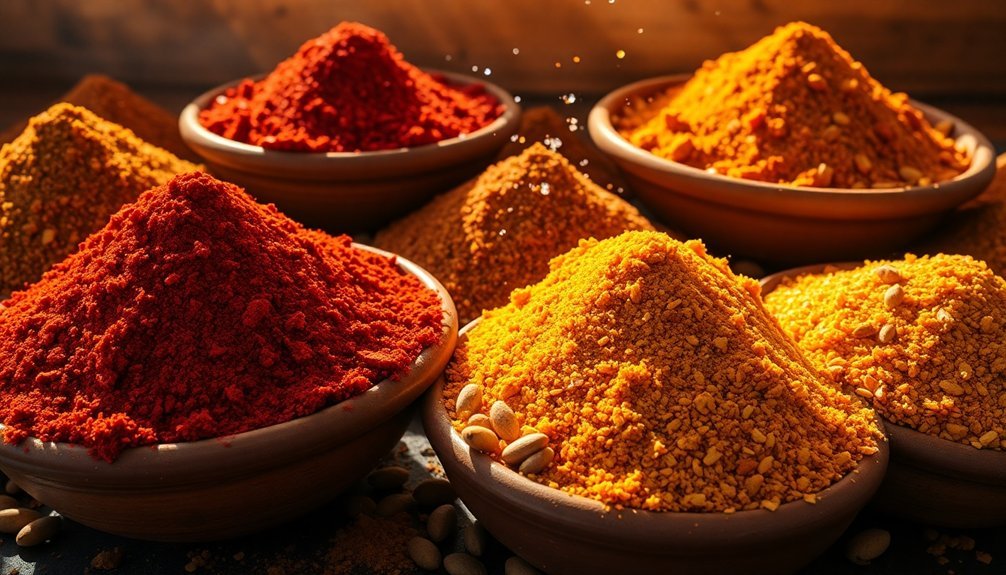
When the Arabs arrived in Morocco during the 7th century, they brought a wealth of exotic spices that would forever transform the region's culinary landscape.
You'll find their influence in the rich array of seasonings from distant lands like China, India, and Malaysia, including cinnamon, ginger, paprika, cumin, and turmeric.
The Persians added another layer of complexity by introducing nuts and dried fruits, creating the signature sweet-and-sour combinations you'll taste in many Moroccan dishes today. This rich blend of ingredients eventually led to the creation of ras el hanout, a complex spice mixture that became central to Moroccan cuisine.
The development of these spice traditions flourished in Morocco's imperial cities – Fes, Meknes, Rabat, and Marrakech – where wealthy courts and dynasties refined the art of seasoning.
Each imperial kitchen contributed to the evolution of distinctive spice blends, establishing Morocco's reputation as a culinary powerhouse.
Heat Management For Spice Drying
Mastering heat control stands as the cornerstone of successful spice drying in Morocco's aromatic traditions.
You'll find that maintaining temperatures between 30°C and 60°C is essential to preserve the key oils that give Moroccan spices their distinct character.
Today's advanced heat pump systems let you dry spices efficiently while cutting operating costs by 70%.
You're able to control both temperature and humidity precisely through computer-controlled ovens equipped with stainless steel trolleys and polyurethane insulation.
The dehumidification process is particularly important, as it harnesses wasted energy while protecting against mold growth.
For best results, you'll want uniform air circulation throughout the drying chamber.
This prevents clumping and guarantees your spices maintain their vibrant colors, authentic flavors, and aromatic compounds that are signature to Moroccan seasonings.
Using food-grade materials in drying equipment ensures the highest level of safety and quality in spice processing.
Solar Preparation Methods
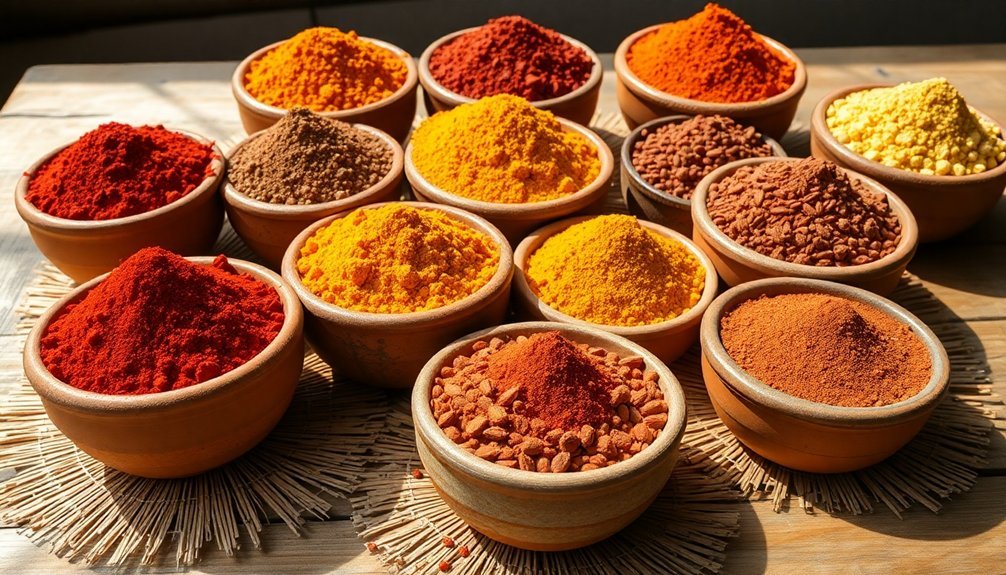
Modern solar drying builds upon traditional heat management techniques, offering an eco-friendly approach to spice preparation.
You'll find that hybrid solar dryers combine natural sunlight with backup heaters, ensuring consistent results even on cloudy days. These systems use perforated panels that pull solar-heated air through your spices, maintaining their essential oils, color, and flavor.
To dry your Moroccan spices, you'll place them on specialized trays inside the dryer, where they'll benefit from homogeneous heat distribution. The same principles apply when cooking with solar-powered ovens, which efficiently prepare dishes like tagines and rice.
You can choose from 5, 10, or 20-tray configurations based on your needs. Remember to stir occasionally for even drying.
With just a small ¾ horsepower engine and the sun's free energy, you're able to process herbs and spices efficiently while preserving their aromatic qualities and nutritional value.
Essential Moroccan Spice Components
The vibrant soul of Moroccan cuisine comes alive through its essential spice components, each contributing distinct flavors and aromas to traditional dishes.
You'll find cumin's earthy notes and coriander's citrus hints forming the foundation of many recipes, while paprika adds warmth and rich color without overwhelming heat. The freshness of spices determines their quality and potency in traditional dishes.
At the heart of Moroccan seasoning lies Ras El Hanout, a complex blend that showcases cinnamon's subtle sweetness, ginger's zesty kick, and sumac's tangy profile.
Beyond these core ingredients, you'll discover luxurious saffron threading golden hues through dishes, while cardamom and nutmeg bring their aromatic depths.
What makes Moroccan spice blends truly unique is their inclusion of ground flowers, exotic barks, and rare spices, creating distinctive flavor profiles you won't find anywhere else.
Sunlight Exposure Duration
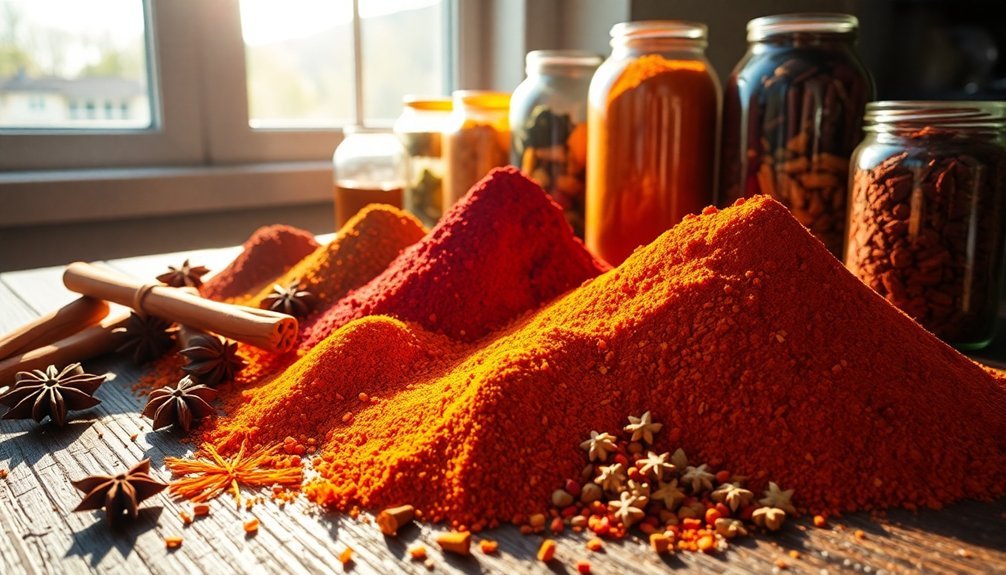
Successful sun drying of Moroccan spices depends heavily on precise sunlight exposure timing and favorable weather conditions.
You'll want to guarantee temperatures exceed 85°F (29°C) with humidity levels below 60% for peak results. While most herbs require careful handling, you'll need to protect their essential oils and volatile compounds from excessive sun exposure.
For your aromatic Moroccan spices, use partial shade or indirect sunlight to prevent degradation of heat-labile compounds.
You'll achieve the best results by rotating your herbs regularly and using reflective surfaces to maintain consistent drying without overwhelming them with direct rays.
Place your drying racks in areas with steady airflow, and monitor the process closely.
Once dried, store your spices in light-protected containers at 50-60°F (10-15°C) to maintain their aromatic qualities.
Proper Drying Equipment
Beyond careful sunlight management, selecting appropriate drying equipment makes a significant difference in preserving Moroccan spices' aromatic qualities.
You'll find heat pump dryers especially effective, as they operate at precise temperatures between 20-80°C, protecting your spices' essential oils while ensuring thorough drying.
If you're handling larger quantities, continuous production dryers offer efficient processing with their S-shaped conveyor system, though you'll need to monitor temperatures carefully to stay within the ideal range for spices.
For smaller batches, dehydrators provide excellent control, operating at gentle temperatures between 95°F and 115°F.
When you're working with particularly delicate herbs and spices, consider oven drying with the door slightly ajar, maintaining temperatures around 100°F to preserve the authentic Moroccan flavors.
Quality Control Measures
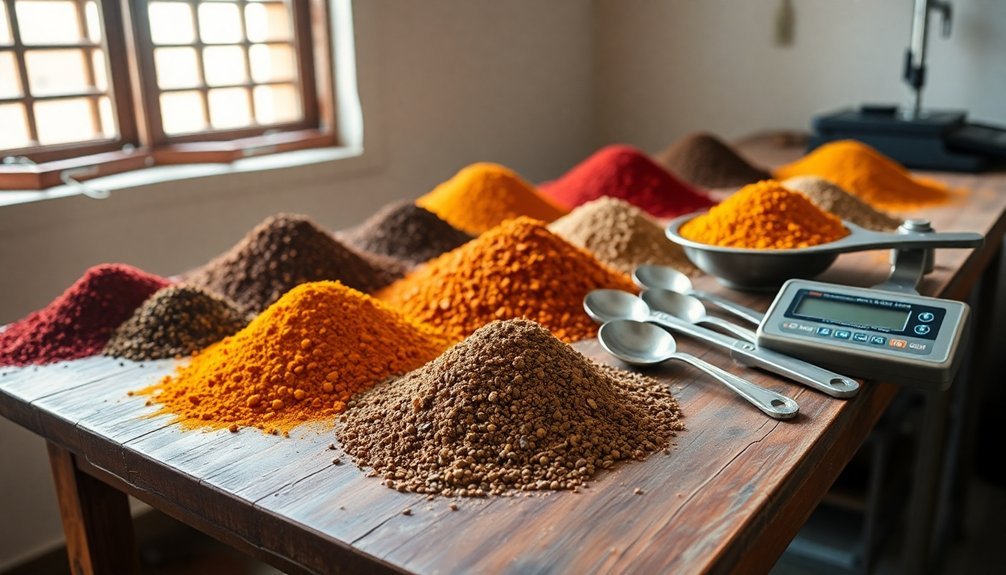
While producing high-quality Moroccan seasonings demands rigorous attention to detail, implementing strict quality control measures guarantees your spices maintain their authentic character.
You'll need to start with thorough cleaning, using techniques like sieving and air blowing to remove dust, stones, and foreign particles that could compromise flavor.
Monitor moisture levels carefully, keeping relative humidity between 40-60% at 20°C to prevent mold and bacterial growth.
You'll want to store your seasonings in airtight containers made of ceramic, aluminum, stainless steel, or dark brown glass. Keep them away from direct sunlight and cooking areas to preserve their aroma and color.
When handling spices, always use dry utensils and transfer opened packages to sealed containers immediately.
Don't store them in the refrigerator, as excess moisture will affect their quality.
Seasonal Spice Adaptations
Just as quality control preserves the integrity of Moroccan seasonings, understanding seasonal adaptations lets you maximize their potential throughout the year.
You'll find that spices like cumin and paprika reach their peak flavor during warmer months, while fresh ginger becomes more abundant in fall and winter.
You can adapt your Moroccan cooking by following traditional seasonal patterns.
In winter, you'll want to embrace warming spices like cinnamon and ginger in hearty stews.
As spring arrives, shift to lighter flavors with fresh ginger and citrusy coriander.
Summer calls for bright notes of paprika and fresh herbs, while fall dishes benefit from preserved lemons and rich spices like nutmeg.
Remember that climate affects spice intensity, so you may need to adjust quantities based on your local conditions.
Storage After Solar Drying
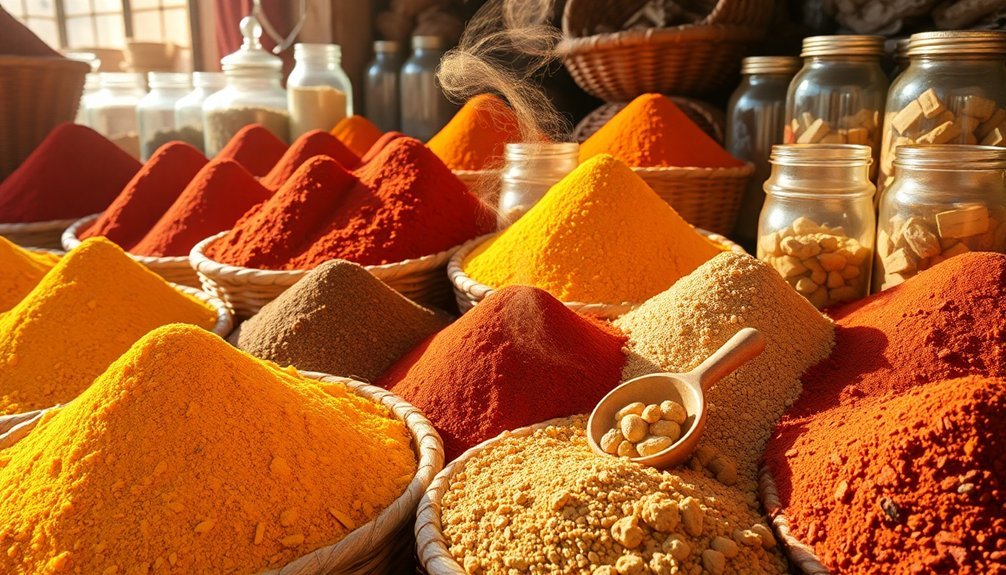
Once your Moroccan spices have been solar-dried, proper storage becomes essential for maintaining their potency and flavor.
You'll want to transfer your spices immediately to airtight glass containers with secure screw-top lids, preferably using amber-colored jars to protect against light damage.
Choose a cool, dark storage location away from your stove and windows – a well-ventilated pantry or kitchen cabinet is ideal.
If you're storing in a humid climate, add a few silica gel beads or a small bag of uncooked rice to your containers.
Don't forget to label each jar with the spice name and drying date.
Keep an eye on your stored spices by checking them periodically for color changes or aroma loss, which can indicate deterioration.
Store strong-flavored Moroccan spices separately to prevent flavor transfer.
Frequently Asked Questions
Can Moroccan Seasonings Be Used in Vegetarian and Vegan Dishes?
Yes, you'll find Moroccan seasonings are perfect for vegetarian and vegan dishes. You can use them to enhance vegetables, legumes, and tofu with warm, complex flavors like cumin, coriander, and ras el hanout.
How Do Moroccan Seasonings Affect the Calorie Content of Dishes?
You'll find that Moroccan seasonings won't increase your dishes' calorie content considerably. They're virtually calorie-free while adding intense flavor, making them perfect for enhancing both light and hearty meals without extra calories.
Are There Any Known Allergic Reactions to Traditional Moroccan Spice Blends?
You can experience allergic reactions to Moroccan spice blends, ranging from skin rashes to severe anaphylaxis. Common triggers include cumin, coriander, and cayenne pepper. It's best to consult your doctor if you're concerned.
Can Children Safely Consume Dishes Prepared With Moroccan Seasonings?
You'll need to be cautious when serving Moroccan-seasoned dishes to children due to potential lead contamination in spices. It's best to source your spices from reputable vendors and limit children's exposure to questionable blends.
Do Moroccan Seasonings Interact With Common Medications or Supplements?
When used in cooking, most Moroccan spices are safe with medications. However, you'll need to be careful with ginger and garlic if you're taking blood thinners. Always check with your doctor first.
In Summary
You'll find that properly sun-dried Moroccan spices retain their potent flavors and aromatic qualities when you follow these traditional methods. Store your dried spices in airtight containers away from direct light, and they'll maintain their intensity for months. Remember, you're not just preserving ingredients – you're carrying forward centuries of Moroccan culinary heritage through these time-tested solar drying techniques.





Leave a Reply